Analysis of Starbucks Marketing Strategies, Research, and Mix
VerifiedAdded on 2020/02/03
|9
|2764
|117
Report
AI Summary
This report provides a detailed analysis of Starbucks' marketing strategies. It begins by examining the marketing techniques used by organizations, specifically focusing on Starbucks and Nintendo. The report then delves into the limitations and constraints of marketing, referencing relevant legislation such as the Sale of Goods Act 1979, the Trade Descriptions Act 1968, and the Consumer Credit Act 1974. The role of market research is explored, highlighting its use in improving goods and services, including primary and secondary research methods, and sampling techniques. The report further discusses the application of market research in planning, considering political, social, and economic factors. It also covers how Starbucks targets customers for selected products through positioning and segmentation strategies. Finally, the report analyzes the marketing mix (price, place, promotion, and product) for new products and services offered by Starbucks, concluding with an overview of the key findings.

Introduction to Marketing
Paraphrase This Document
Need a fresh take? Get an instant paraphrase of this document with our AI Paraphraser
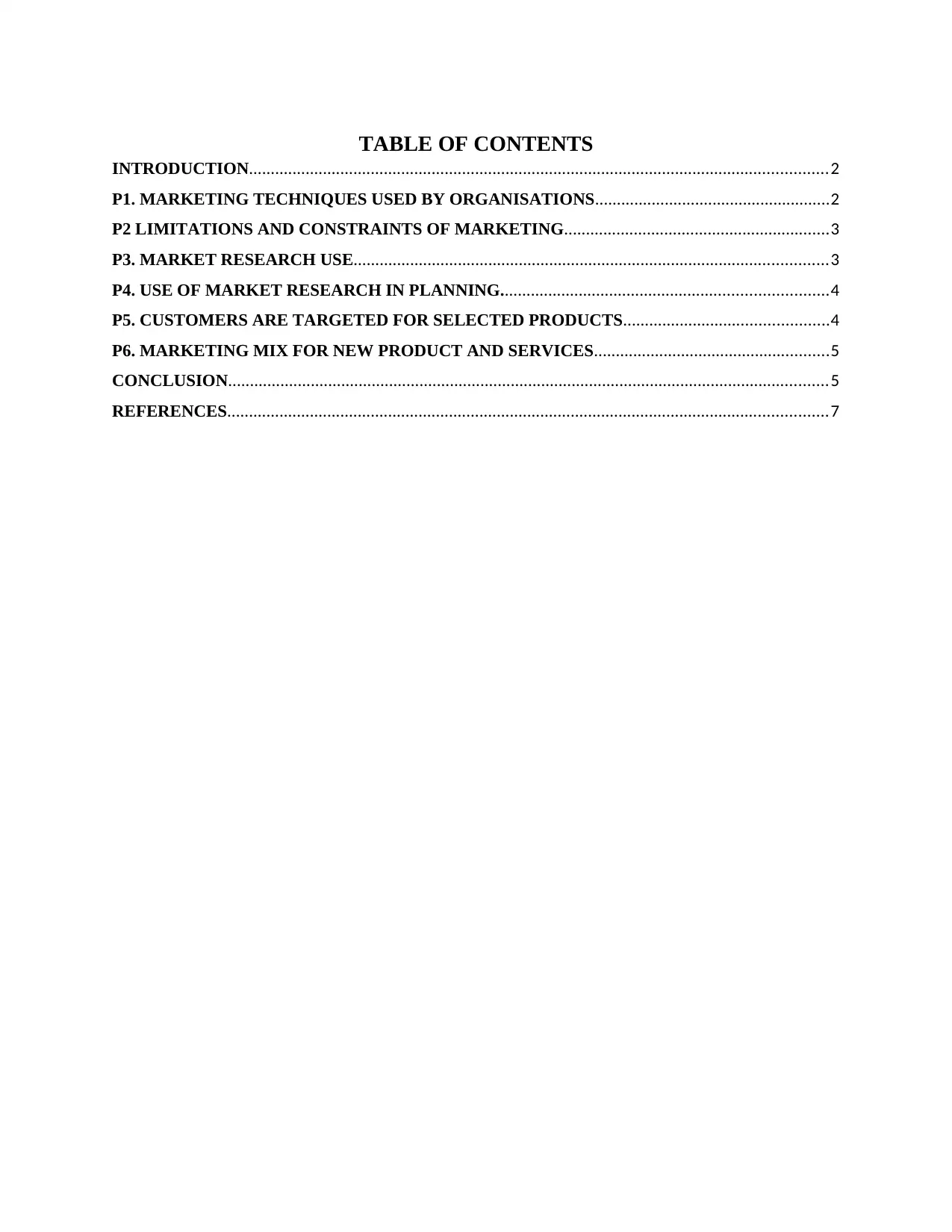
TABLE OF CONTENTS
INTRODUCTION.....................................................................................................................................2
P1. MARKETING TECHNIQUES USED BY ORGANISATIONS......................................................2
P2 LIMITATIONS AND CONSTRAINTS OF MARKETING.............................................................3
P3. MARKET RESEARCH USE.............................................................................................................3
P4. USE OF MARKET RESEARCH IN PLANNING...........................................................................4
P5. CUSTOMERS ARE TARGETED FOR SELECTED PRODUCTS...............................................4
P6. MARKETING MIX FOR NEW PRODUCT AND SERVICES......................................................5
CONCLUSION..........................................................................................................................................5
REFERENCES..........................................................................................................................................7
INTRODUCTION.....................................................................................................................................2
P1. MARKETING TECHNIQUES USED BY ORGANISATIONS......................................................2
P2 LIMITATIONS AND CONSTRAINTS OF MARKETING.............................................................3
P3. MARKET RESEARCH USE.............................................................................................................3
P4. USE OF MARKET RESEARCH IN PLANNING...........................................................................4
P5. CUSTOMERS ARE TARGETED FOR SELECTED PRODUCTS...............................................4
P6. MARKETING MIX FOR NEW PRODUCT AND SERVICES......................................................5
CONCLUSION..........................................................................................................................................5
REFERENCES..........................................................................................................................................7
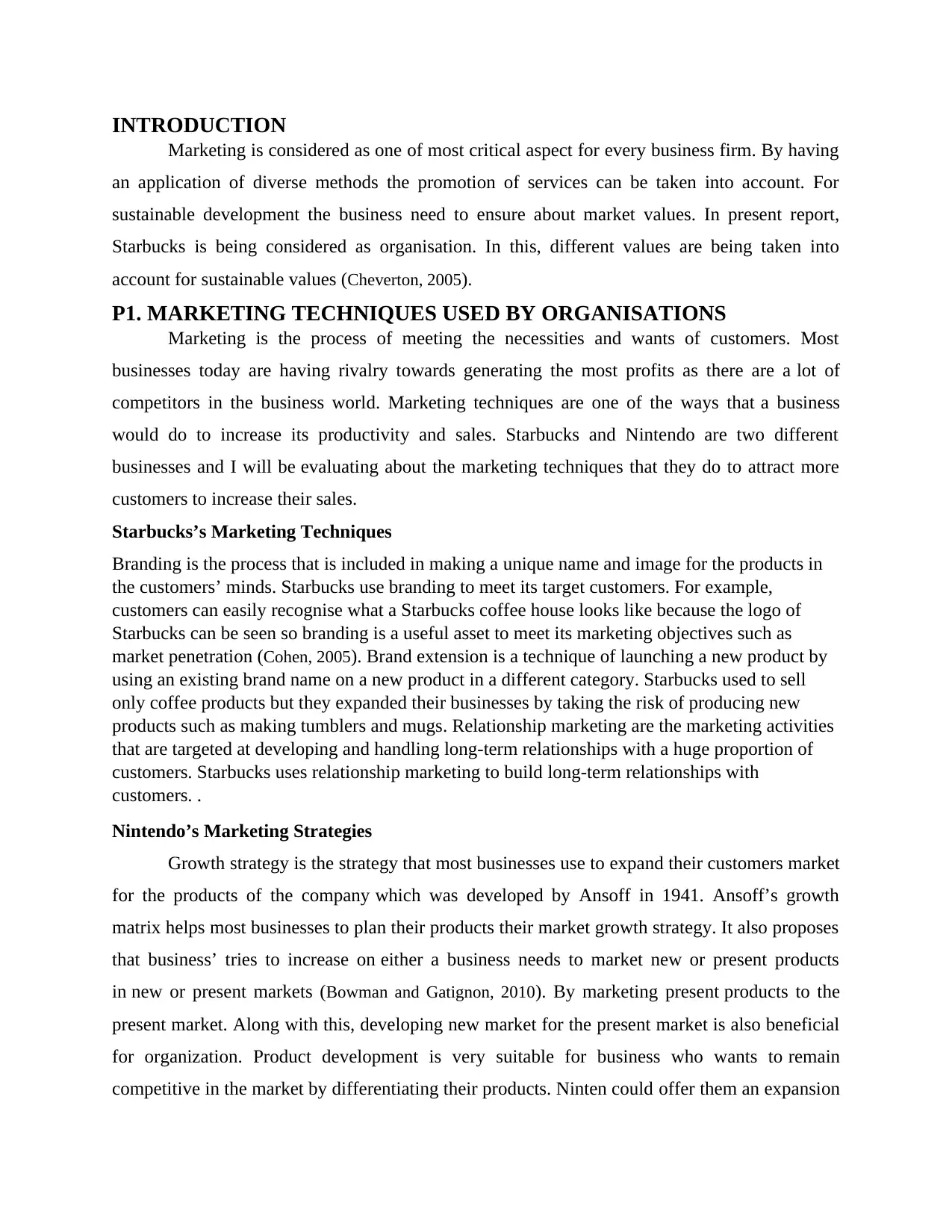
INTRODUCTION
Marketing is considered as one of most critical aspect for every business firm. By having
an application of diverse methods the promotion of services can be taken into account. For
sustainable development the business need to ensure about market values. In present report,
Starbucks is being considered as organisation. In this, different values are being taken into
account for sustainable values (Cheverton, 2005).
P1. MARKETING TECHNIQUES USED BY ORGANISATIONS
Marketing is the process of meeting the necessities and wants of customers. Most
businesses today are having rivalry towards generating the most profits as there are a lot of
competitors in the business world. Marketing techniques are one of the ways that a business
would do to increase its productivity and sales. Starbucks and Nintendo are two different
businesses and I will be evaluating about the marketing techniques that they do to attract more
customers to increase their sales.
Starbucks’s Marketing Techniques
Branding is the process that is included in making a unique name and image for the products in
the customers’ minds. Starbucks use branding to meet its target customers. For example,
customers can easily recognise what a Starbucks coffee house looks like because the logo of
Starbucks can be seen so branding is a useful asset to meet its marketing objectives such as
market penetration (Cohen, 2005). Brand extension is a technique of launching a new product by
using an existing brand name on a new product in a different category. Starbucks used to sell
only coffee products but they expanded their businesses by taking the risk of producing new
products such as making tumblers and mugs. Relationship marketing are the marketing activities
that are targeted at developing and handling long-term relationships with a huge proportion of
customers. Starbucks uses relationship marketing to build long-term relationships with
customers. .
Nintendo’s Marketing Strategies
Growth strategy is the strategy that most businesses use to expand their customers market
for the products of the company which was developed by Ansoff in 1941. Ansoff’s growth
matrix helps most businesses to plan their products their market growth strategy. It also proposes
that business’ tries to increase on either a business needs to market new or present products
in new or present markets (Bowman and Gatignon, 2010). By marketing present products to the
present market. Along with this, developing new market for the present market is also beneficial
for organization. Product development is very suitable for business who wants to remain
competitive in the market by differentiating their products. Ninten could offer them an expansion
Marketing is considered as one of most critical aspect for every business firm. By having
an application of diverse methods the promotion of services can be taken into account. For
sustainable development the business need to ensure about market values. In present report,
Starbucks is being considered as organisation. In this, different values are being taken into
account for sustainable values (Cheverton, 2005).
P1. MARKETING TECHNIQUES USED BY ORGANISATIONS
Marketing is the process of meeting the necessities and wants of customers. Most
businesses today are having rivalry towards generating the most profits as there are a lot of
competitors in the business world. Marketing techniques are one of the ways that a business
would do to increase its productivity and sales. Starbucks and Nintendo are two different
businesses and I will be evaluating about the marketing techniques that they do to attract more
customers to increase their sales.
Starbucks’s Marketing Techniques
Branding is the process that is included in making a unique name and image for the products in
the customers’ minds. Starbucks use branding to meet its target customers. For example,
customers can easily recognise what a Starbucks coffee house looks like because the logo of
Starbucks can be seen so branding is a useful asset to meet its marketing objectives such as
market penetration (Cohen, 2005). Brand extension is a technique of launching a new product by
using an existing brand name on a new product in a different category. Starbucks used to sell
only coffee products but they expanded their businesses by taking the risk of producing new
products such as making tumblers and mugs. Relationship marketing are the marketing activities
that are targeted at developing and handling long-term relationships with a huge proportion of
customers. Starbucks uses relationship marketing to build long-term relationships with
customers. .
Nintendo’s Marketing Strategies
Growth strategy is the strategy that most businesses use to expand their customers market
for the products of the company which was developed by Ansoff in 1941. Ansoff’s growth
matrix helps most businesses to plan their products their market growth strategy. It also proposes
that business’ tries to increase on either a business needs to market new or present products
in new or present markets (Bowman and Gatignon, 2010). By marketing present products to the
present market. Along with this, developing new market for the present market is also beneficial
for organization. Product development is very suitable for business who wants to remain
competitive in the market by differentiating their products. Ninten could offer them an expansion
⊘ This is a preview!⊘
Do you want full access?
Subscribe today to unlock all pages.

Trusted by 1+ million students worldwide
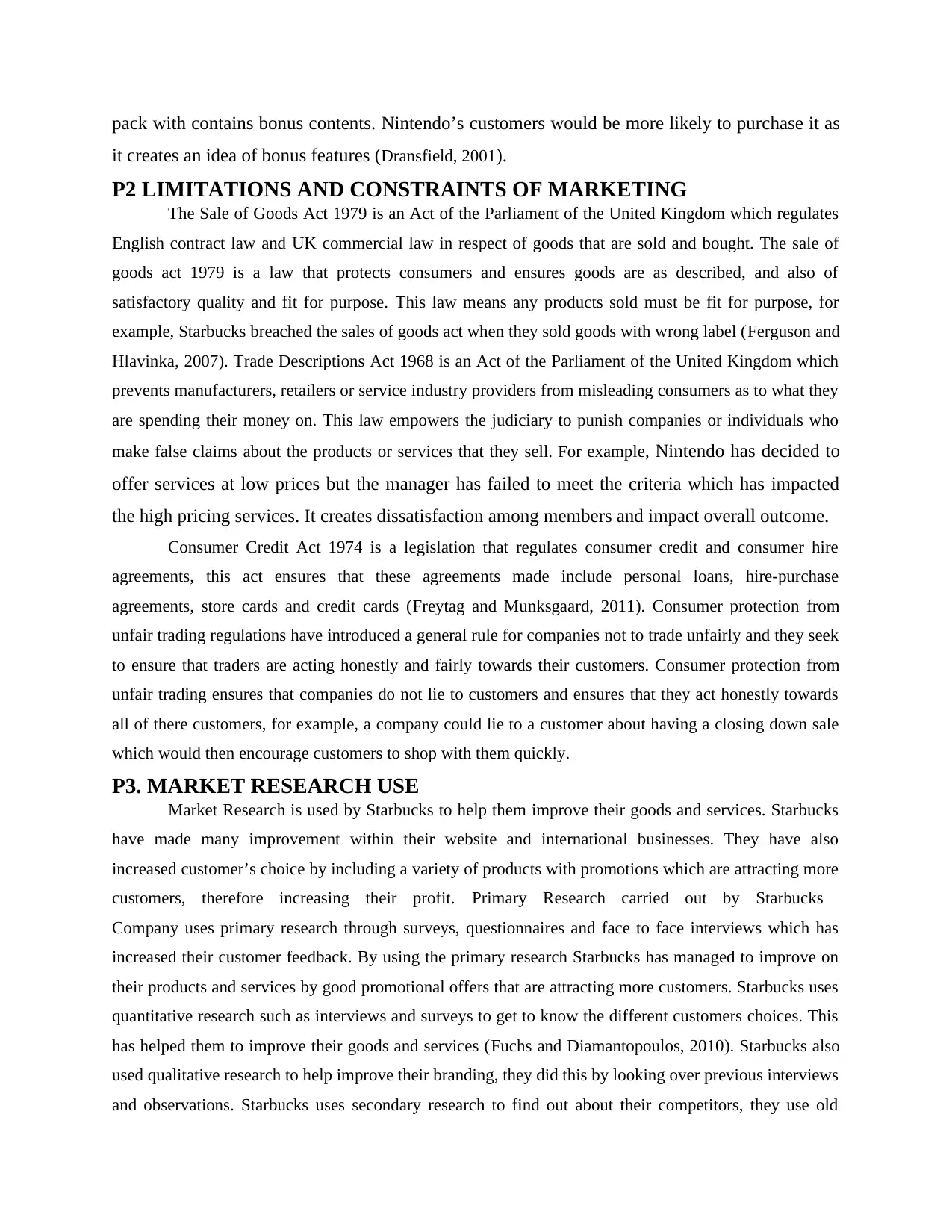
pack with contains bonus contents. Nintendo’s customers would be more likely to purchase it as
it creates an idea of bonus features (Dransfield, 2001).
P2 LIMITATIONS AND CONSTRAINTS OF MARKETING
The Sale of Goods Act 1979 is an Act of the Parliament of the United Kingdom which regulates
English contract law and UK commercial law in respect of goods that are sold and bought. The sale of
goods act 1979 is a law that protects consumers and ensures goods are as described, and also of
satisfactory quality and fit for purpose. This law means any products sold must be fit for purpose, for
example, Starbucks breached the sales of goods act when they sold goods with wrong label (Ferguson and
Hlavinka, 2007). Trade Descriptions Act 1968 is an Act of the Parliament of the United Kingdom which
prevents manufacturers, retailers or service industry providers from misleading consumers as to what they
are spending their money on. This law empowers the judiciary to punish companies or individuals who
make false claims about the products or services that they sell. For example, Nintendo has decided to
offer services at low prices but the manager has failed to meet the criteria which has impacted
the high pricing services. It creates dissatisfaction among members and impact overall outcome.
Consumer Credit Act 1974 is a legislation that regulates consumer credit and consumer hire
agreements, this act ensures that these agreements made include personal loans, hire-purchase
agreements, store cards and credit cards (Freytag and Munksgaard, 2011). Consumer protection from
unfair trading regulations have introduced a general rule for companies not to trade unfairly and they seek
to ensure that traders are acting honestly and fairly towards their customers. Consumer protection from
unfair trading ensures that companies do not lie to customers and ensures that they act honestly towards
all of there customers, for example, a company could lie to a customer about having a closing down sale
which would then encourage customers to shop with them quickly.
P3. MARKET RESEARCH USE
Market Research is used by Starbucks to help them improve their goods and services. Starbucks
have made many improvement within their website and international businesses. They have also
increased customer’s choice by including a variety of products with promotions which are attracting more
customers, therefore increasing their profit. Primary Research carried out by Starbucks
Company uses primary research through surveys, questionnaires and face to face interviews which has
increased their customer feedback. By using the primary research Starbucks has managed to improve on
their products and services by good promotional offers that are attracting more customers. Starbucks uses
quantitative research such as interviews and surveys to get to know the different customers choices. This
has helped them to improve their goods and services (Fuchs and Diamantopoulos, 2010). Starbucks also
used qualitative research to help improve their branding, they did this by looking over previous interviews
and observations. Starbucks uses secondary research to find out about their competitors, they use old
it creates an idea of bonus features (Dransfield, 2001).
P2 LIMITATIONS AND CONSTRAINTS OF MARKETING
The Sale of Goods Act 1979 is an Act of the Parliament of the United Kingdom which regulates
English contract law and UK commercial law in respect of goods that are sold and bought. The sale of
goods act 1979 is a law that protects consumers and ensures goods are as described, and also of
satisfactory quality and fit for purpose. This law means any products sold must be fit for purpose, for
example, Starbucks breached the sales of goods act when they sold goods with wrong label (Ferguson and
Hlavinka, 2007). Trade Descriptions Act 1968 is an Act of the Parliament of the United Kingdom which
prevents manufacturers, retailers or service industry providers from misleading consumers as to what they
are spending their money on. This law empowers the judiciary to punish companies or individuals who
make false claims about the products or services that they sell. For example, Nintendo has decided to
offer services at low prices but the manager has failed to meet the criteria which has impacted
the high pricing services. It creates dissatisfaction among members and impact overall outcome.
Consumer Credit Act 1974 is a legislation that regulates consumer credit and consumer hire
agreements, this act ensures that these agreements made include personal loans, hire-purchase
agreements, store cards and credit cards (Freytag and Munksgaard, 2011). Consumer protection from
unfair trading regulations have introduced a general rule for companies not to trade unfairly and they seek
to ensure that traders are acting honestly and fairly towards their customers. Consumer protection from
unfair trading ensures that companies do not lie to customers and ensures that they act honestly towards
all of there customers, for example, a company could lie to a customer about having a closing down sale
which would then encourage customers to shop with them quickly.
P3. MARKET RESEARCH USE
Market Research is used by Starbucks to help them improve their goods and services. Starbucks
have made many improvement within their website and international businesses. They have also
increased customer’s choice by including a variety of products with promotions which are attracting more
customers, therefore increasing their profit. Primary Research carried out by Starbucks
Company uses primary research through surveys, questionnaires and face to face interviews which has
increased their customer feedback. By using the primary research Starbucks has managed to improve on
their products and services by good promotional offers that are attracting more customers. Starbucks uses
quantitative research such as interviews and surveys to get to know the different customers choices. This
has helped them to improve their goods and services (Fuchs and Diamantopoulos, 2010). Starbucks also
used qualitative research to help improve their branding, they did this by looking over previous interviews
and observations. Starbucks uses secondary research to find out about their competitors, they use old
Paraphrase This Document
Need a fresh take? Get an instant paraphrase of this document with our AI Paraphraser
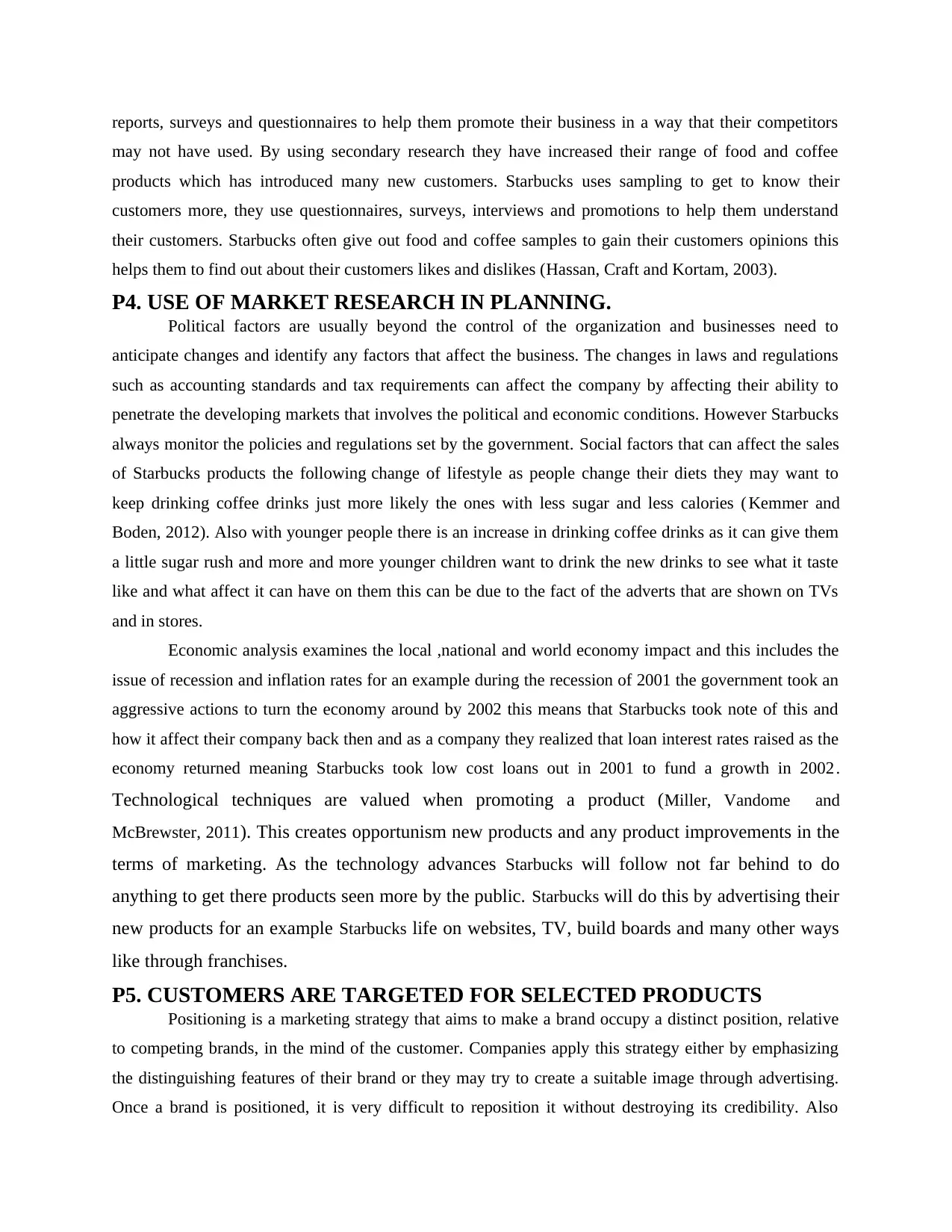
reports, surveys and questionnaires to help them promote their business in a way that their competitors
may not have used. By using secondary research they have increased their range of food and coffee
products which has introduced many new customers. Starbucks uses sampling to get to know their
customers more, they use questionnaires, surveys, interviews and promotions to help them understand
their customers. Starbucks often give out food and coffee samples to gain their customers opinions this
helps them to find out about their customers likes and dislikes (Hassan, Craft and Kortam, 2003).
P4. USE OF MARKET RESEARCH IN PLANNING.
Political factors are usually beyond the control of the organization and businesses need to
anticipate changes and identify any factors that affect the business. The changes in laws and regulations
such as accounting standards and tax requirements can affect the company by affecting their ability to
penetrate the developing markets that involves the political and economic conditions. However Starbucks
always monitor the policies and regulations set by the government. Social factors that can affect the sales
of Starbucks products the following change of lifestyle as people change their diets they may want to
keep drinking coffee drinks just more likely the ones with less sugar and less calories ( Kemmer and
Boden, 2012). Also with younger people there is an increase in drinking coffee drinks as it can give them
a little sugar rush and more and more younger children want to drink the new drinks to see what it taste
like and what affect it can have on them this can be due to the fact of the adverts that are shown on TVs
and in stores.
Economic analysis examines the local ,national and world economy impact and this includes the
issue of recession and inflation rates for an example during the recession of 2001 the government took an
aggressive actions to turn the economy around by 2002 this means that Starbucks took note of this and
how it affect their company back then and as a company they realized that loan interest rates raised as the
economy returned meaning Starbucks took low cost loans out in 2001 to fund a growth in 2002 .
Technological techniques are valued when promoting a product (Miller, Vandome and
McBrewster, 2011). This creates opportunism new products and any product improvements in the
terms of marketing. As the technology advances Starbucks will follow not far behind to do
anything to get there products seen more by the public. Starbucks will do this by advertising their
new products for an example Starbucks life on websites, TV, build boards and many other ways
like through franchises.
P5. CUSTOMERS ARE TARGETED FOR SELECTED PRODUCTS
Positioning is a marketing strategy that aims to make a brand occupy a distinct position, relative
to competing brands, in the mind of the customer. Companies apply this strategy either by emphasizing
the distinguishing features of their brand or they may try to create a suitable image through advertising.
Once a brand is positioned, it is very difficult to reposition it without destroying its credibility. Also
may not have used. By using secondary research they have increased their range of food and coffee
products which has introduced many new customers. Starbucks uses sampling to get to know their
customers more, they use questionnaires, surveys, interviews and promotions to help them understand
their customers. Starbucks often give out food and coffee samples to gain their customers opinions this
helps them to find out about their customers likes and dislikes (Hassan, Craft and Kortam, 2003).
P4. USE OF MARKET RESEARCH IN PLANNING.
Political factors are usually beyond the control of the organization and businesses need to
anticipate changes and identify any factors that affect the business. The changes in laws and regulations
such as accounting standards and tax requirements can affect the company by affecting their ability to
penetrate the developing markets that involves the political and economic conditions. However Starbucks
always monitor the policies and regulations set by the government. Social factors that can affect the sales
of Starbucks products the following change of lifestyle as people change their diets they may want to
keep drinking coffee drinks just more likely the ones with less sugar and less calories ( Kemmer and
Boden, 2012). Also with younger people there is an increase in drinking coffee drinks as it can give them
a little sugar rush and more and more younger children want to drink the new drinks to see what it taste
like and what affect it can have on them this can be due to the fact of the adverts that are shown on TVs
and in stores.
Economic analysis examines the local ,national and world economy impact and this includes the
issue of recession and inflation rates for an example during the recession of 2001 the government took an
aggressive actions to turn the economy around by 2002 this means that Starbucks took note of this and
how it affect their company back then and as a company they realized that loan interest rates raised as the
economy returned meaning Starbucks took low cost loans out in 2001 to fund a growth in 2002 .
Technological techniques are valued when promoting a product (Miller, Vandome and
McBrewster, 2011). This creates opportunism new products and any product improvements in the
terms of marketing. As the technology advances Starbucks will follow not far behind to do
anything to get there products seen more by the public. Starbucks will do this by advertising their
new products for an example Starbucks life on websites, TV, build boards and many other ways
like through franchises.
P5. CUSTOMERS ARE TARGETED FOR SELECTED PRODUCTS
Positioning is a marketing strategy that aims to make a brand occupy a distinct position, relative
to competing brands, in the mind of the customer. Companies apply this strategy either by emphasizing
the distinguishing features of their brand or they may try to create a suitable image through advertising.
Once a brand is positioned, it is very difficult to reposition it without destroying its credibility. Also
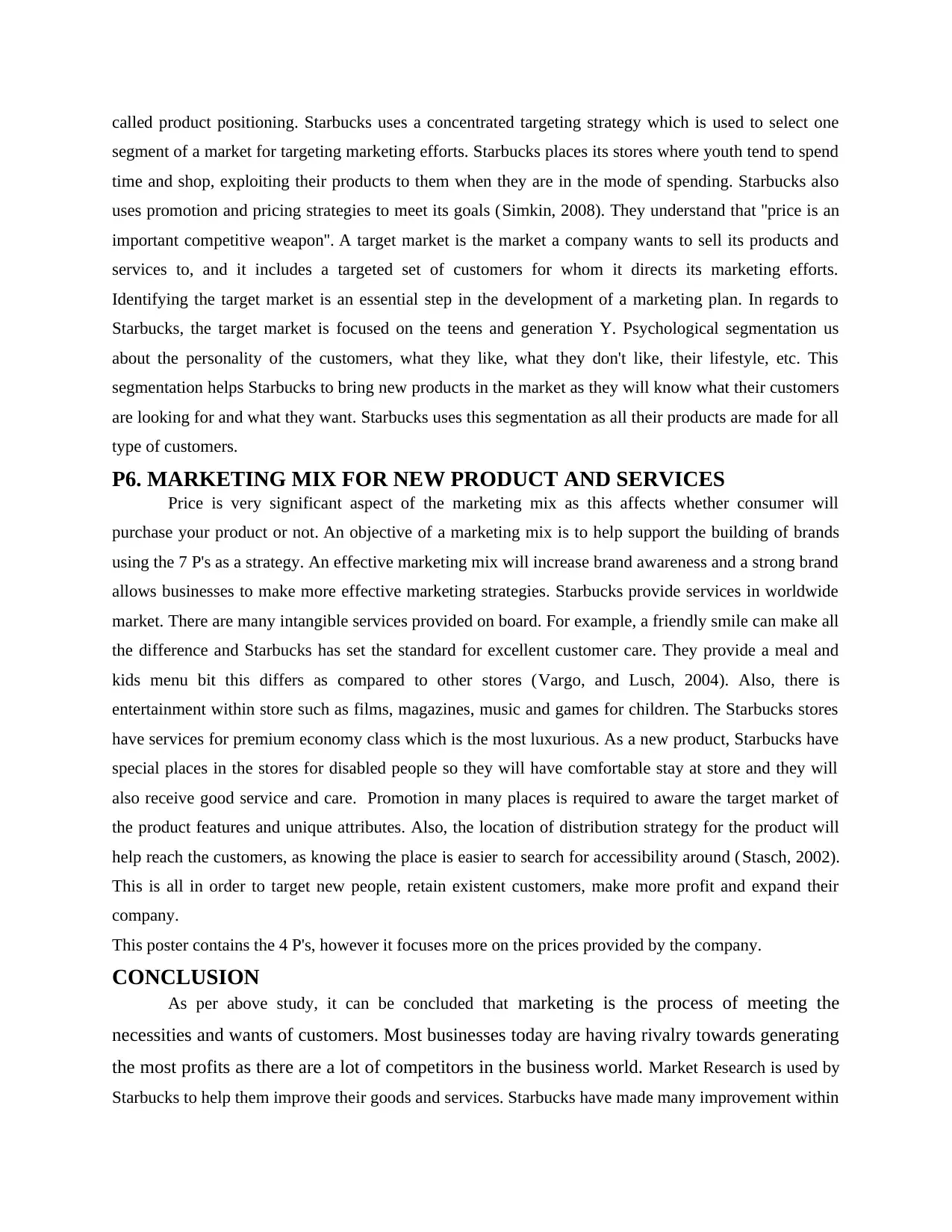
called product positioning. Starbucks uses a concentrated targeting strategy which is used to select one
segment of a market for targeting marketing efforts. Starbucks places its stores where youth tend to spend
time and shop, exploiting their products to them when they are in the mode of spending. Starbucks also
uses promotion and pricing strategies to meet its goals (Simkin, 2008). They understand that ''price is an
important competitive weapon''. A target market is the market a company wants to sell its products and
services to, and it includes a targeted set of customers for whom it directs its marketing efforts.
Identifying the target market is an essential step in the development of a marketing plan. In regards to
Starbucks, the target market is focused on the teens and generation Y. Psychological segmentation us
about the personality of the customers, what they like, what they don't like, their lifestyle, etc. This
segmentation helps Starbucks to bring new products in the market as they will know what their customers
are looking for and what they want. Starbucks uses this segmentation as all their products are made for all
type of customers.
P6. MARKETING MIX FOR NEW PRODUCT AND SERVICES
Price is very significant aspect of the marketing mix as this affects whether consumer will
purchase your product or not. An objective of a marketing mix is to help support the building of brands
using the 7 P's as a strategy. An effective marketing mix will increase brand awareness and a strong brand
allows businesses to make more effective marketing strategies. Starbucks provide services in worldwide
market. There are many intangible services provided on board. For example, a friendly smile can make all
the difference and Starbucks has set the standard for excellent customer care. They provide a meal and
kids menu bit this differs as compared to other stores (Vargo, and Lusch, 2004). Also, there is
entertainment within store such as films, magazines, music and games for children. The Starbucks stores
have services for premium economy class which is the most luxurious. As a new product, Starbucks have
special places in the stores for disabled people so they will have comfortable stay at store and they will
also receive good service and care. Promotion in many places is required to aware the target market of
the product features and unique attributes. Also, the location of distribution strategy for the product will
help reach the customers, as knowing the place is easier to search for accessibility around ( Stasch, 2002).
This is all in order to target new people, retain existent customers, make more profit and expand their
company.
This poster contains the 4 P's, however it focuses more on the prices provided by the company.
CONCLUSION
As per above study, it can be concluded that marketing is the process of meeting the
necessities and wants of customers. Most businesses today are having rivalry towards generating
the most profits as there are a lot of competitors in the business world. Market Research is used by
Starbucks to help them improve their goods and services. Starbucks have made many improvement within
segment of a market for targeting marketing efforts. Starbucks places its stores where youth tend to spend
time and shop, exploiting their products to them when they are in the mode of spending. Starbucks also
uses promotion and pricing strategies to meet its goals (Simkin, 2008). They understand that ''price is an
important competitive weapon''. A target market is the market a company wants to sell its products and
services to, and it includes a targeted set of customers for whom it directs its marketing efforts.
Identifying the target market is an essential step in the development of a marketing plan. In regards to
Starbucks, the target market is focused on the teens and generation Y. Psychological segmentation us
about the personality of the customers, what they like, what they don't like, their lifestyle, etc. This
segmentation helps Starbucks to bring new products in the market as they will know what their customers
are looking for and what they want. Starbucks uses this segmentation as all their products are made for all
type of customers.
P6. MARKETING MIX FOR NEW PRODUCT AND SERVICES
Price is very significant aspect of the marketing mix as this affects whether consumer will
purchase your product or not. An objective of a marketing mix is to help support the building of brands
using the 7 P's as a strategy. An effective marketing mix will increase brand awareness and a strong brand
allows businesses to make more effective marketing strategies. Starbucks provide services in worldwide
market. There are many intangible services provided on board. For example, a friendly smile can make all
the difference and Starbucks has set the standard for excellent customer care. They provide a meal and
kids menu bit this differs as compared to other stores (Vargo, and Lusch, 2004). Also, there is
entertainment within store such as films, magazines, music and games for children. The Starbucks stores
have services for premium economy class which is the most luxurious. As a new product, Starbucks have
special places in the stores for disabled people so they will have comfortable stay at store and they will
also receive good service and care. Promotion in many places is required to aware the target market of
the product features and unique attributes. Also, the location of distribution strategy for the product will
help reach the customers, as knowing the place is easier to search for accessibility around ( Stasch, 2002).
This is all in order to target new people, retain existent customers, make more profit and expand their
company.
This poster contains the 4 P's, however it focuses more on the prices provided by the company.
CONCLUSION
As per above study, it can be concluded that marketing is the process of meeting the
necessities and wants of customers. Most businesses today are having rivalry towards generating
the most profits as there are a lot of competitors in the business world. Market Research is used by
Starbucks to help them improve their goods and services. Starbucks have made many improvement within
⊘ This is a preview!⊘
Do you want full access?
Subscribe today to unlock all pages.

Trusted by 1+ million students worldwide
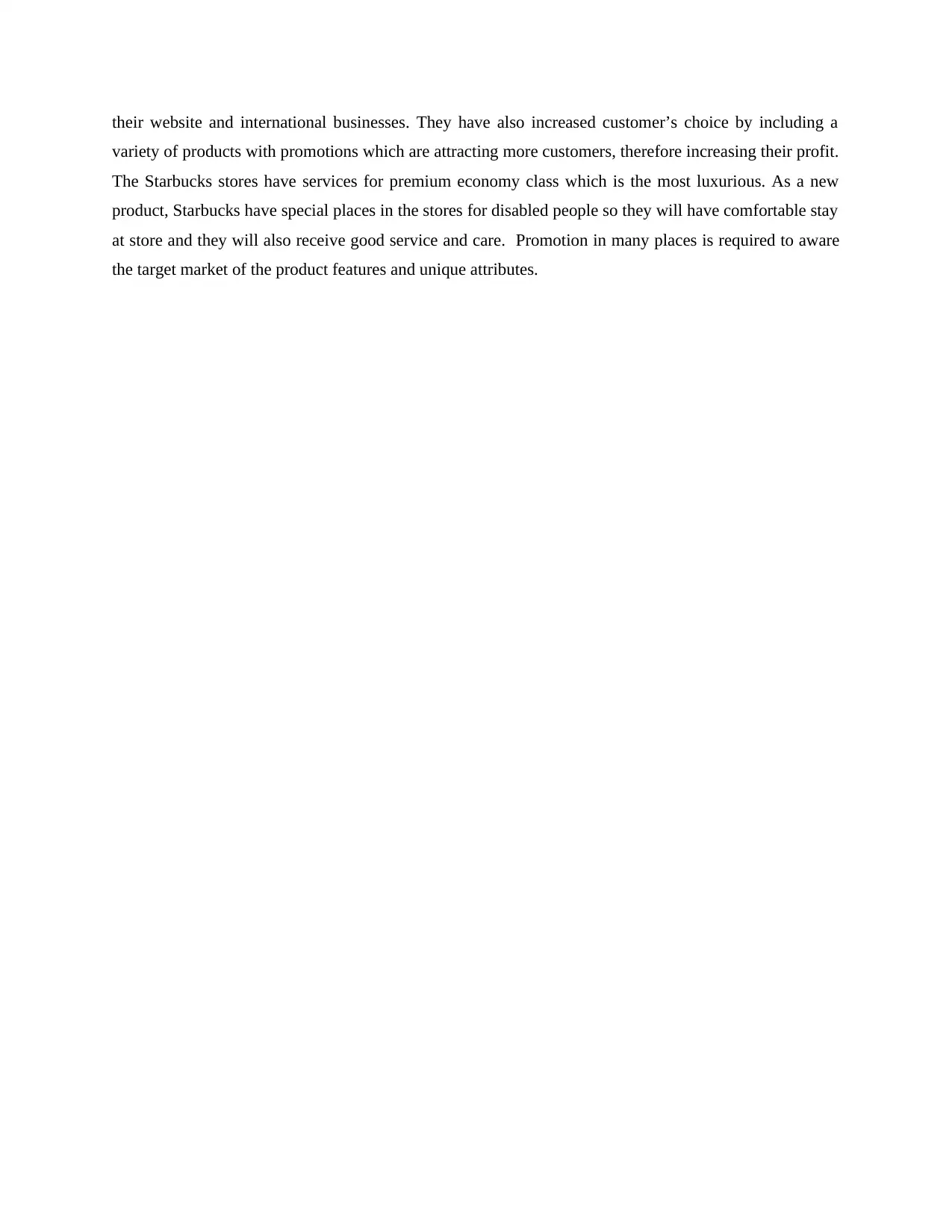
their website and international businesses. They have also increased customer’s choice by including a
variety of products with promotions which are attracting more customers, therefore increasing their profit.
The Starbucks stores have services for premium economy class which is the most luxurious. As a new
product, Starbucks have special places in the stores for disabled people so they will have comfortable stay
at store and they will also receive good service and care. Promotion in many places is required to aware
the target market of the product features and unique attributes.
variety of products with promotions which are attracting more customers, therefore increasing their profit.
The Starbucks stores have services for premium economy class which is the most luxurious. As a new
product, Starbucks have special places in the stores for disabled people so they will have comfortable stay
at store and they will also receive good service and care. Promotion in many places is required to aware
the target market of the product features and unique attributes.
Paraphrase This Document
Need a fresh take? Get an instant paraphrase of this document with our AI Paraphraser
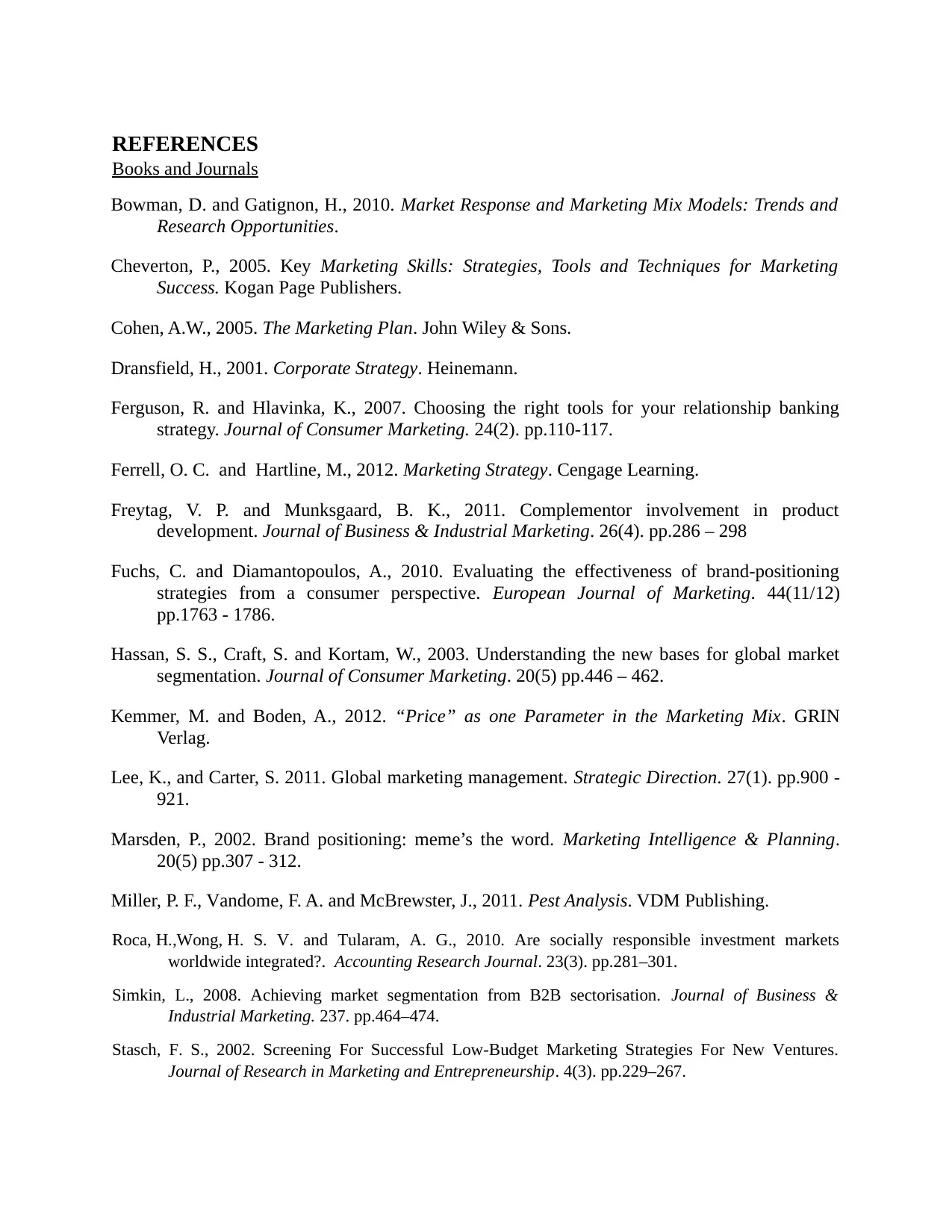
REFERENCES
Books and Journals
Bowman, D. and Gatignon, H., 2010. Market Response and Marketing Mix Models: Trends and
Research Opportunities.
Cheverton, P., 2005. Key Marketing Skills: Strategies, Tools and Techniques for Marketing
Success. Kogan Page Publishers.
Cohen, A.W., 2005. The Marketing Plan. John Wiley & Sons.
Dransfield, H., 2001. Corporate Strategy. Heinemann.
Ferguson, R. and Hlavinka, K., 2007. Choosing the right tools for your relationship banking
strategy. Journal of Consumer Marketing. 24(2). pp.110-117.
Ferrell, O. C. and Hartline, M., 2012. Marketing Strategy. Cengage Learning.
Freytag, V. P. and Munksgaard, B. K., 2011. Complementor involvement in product
development. Journal of Business & Industrial Marketing. 26(4). pp.286 – 298
Fuchs, C. and Diamantopoulos, A., 2010. Evaluating the effectiveness of brand-positioning
strategies from a consumer perspective. European Journal of Marketing. 44(11/12)
pp.1763 - 1786.
Hassan, S. S., Craft, S. and Kortam, W., 2003. Understanding the new bases for global market
segmentation. Journal of Consumer Marketing. 20(5) pp.446 – 462.
Kemmer, M. and Boden, A., 2012. “Price” as one Parameter in the Marketing Mix. GRIN
Verlag.
Lee, K., and Carter, S. 2011. Global marketing management. Strategic Direction. 27(1). pp.900 -
921.
Marsden, P., 2002. Brand positioning: meme’s the word. Marketing Intelligence & Planning.
20(5) pp.307 - 312.
Miller, P. F., Vandome, F. A. and McBrewster, J., 2011. Pest Analysis. VDM Publishing.
Roca, H.,Wong, H. S. V. and Tularam, A. G., 2010. Are socially responsible investment markets
worldwide integrated?. Accounting Research Journal. 23(3). pp.281–301.
Simkin, L., 2008. Achieving market segmentation from B2B sectorisation. Journal of Business &
Industrial Marketing. 237. pp.464–474.
Stasch, F. S., 2002. Screening For Successful Low-Budget Marketing Strategies For New Ventures.
Journal of Research in Marketing and Entrepreneurship. 4(3). pp.229–267.
Books and Journals
Bowman, D. and Gatignon, H., 2010. Market Response and Marketing Mix Models: Trends and
Research Opportunities.
Cheverton, P., 2005. Key Marketing Skills: Strategies, Tools and Techniques for Marketing
Success. Kogan Page Publishers.
Cohen, A.W., 2005. The Marketing Plan. John Wiley & Sons.
Dransfield, H., 2001. Corporate Strategy. Heinemann.
Ferguson, R. and Hlavinka, K., 2007. Choosing the right tools for your relationship banking
strategy. Journal of Consumer Marketing. 24(2). pp.110-117.
Ferrell, O. C. and Hartline, M., 2012. Marketing Strategy. Cengage Learning.
Freytag, V. P. and Munksgaard, B. K., 2011. Complementor involvement in product
development. Journal of Business & Industrial Marketing. 26(4). pp.286 – 298
Fuchs, C. and Diamantopoulos, A., 2010. Evaluating the effectiveness of brand-positioning
strategies from a consumer perspective. European Journal of Marketing. 44(11/12)
pp.1763 - 1786.
Hassan, S. S., Craft, S. and Kortam, W., 2003. Understanding the new bases for global market
segmentation. Journal of Consumer Marketing. 20(5) pp.446 – 462.
Kemmer, M. and Boden, A., 2012. “Price” as one Parameter in the Marketing Mix. GRIN
Verlag.
Lee, K., and Carter, S. 2011. Global marketing management. Strategic Direction. 27(1). pp.900 -
921.
Marsden, P., 2002. Brand positioning: meme’s the word. Marketing Intelligence & Planning.
20(5) pp.307 - 312.
Miller, P. F., Vandome, F. A. and McBrewster, J., 2011. Pest Analysis. VDM Publishing.
Roca, H.,Wong, H. S. V. and Tularam, A. G., 2010. Are socially responsible investment markets
worldwide integrated?. Accounting Research Journal. 23(3). pp.281–301.
Simkin, L., 2008. Achieving market segmentation from B2B sectorisation. Journal of Business &
Industrial Marketing. 237. pp.464–474.
Stasch, F. S., 2002. Screening For Successful Low-Budget Marketing Strategies For New Ventures.
Journal of Research in Marketing and Entrepreneurship. 4(3). pp.229–267.
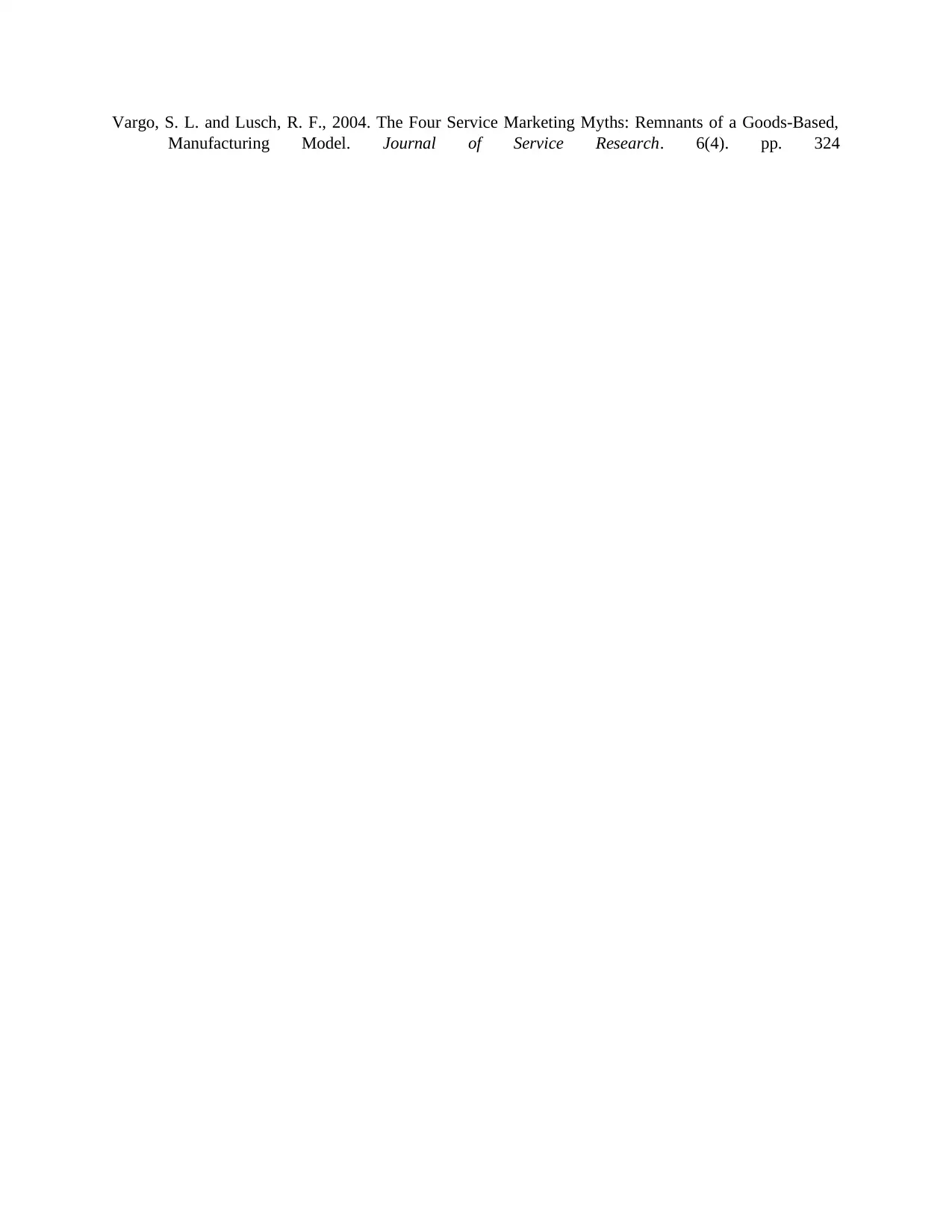
Vargo, S. L. and Lusch, R. F., 2004. The Four Service Marketing Myths: Remnants of a Goods-Based,
Manufacturing Model. Journal of Service Research. 6(4). pp. 324
Manufacturing Model. Journal of Service Research. 6(4). pp. 324
⊘ This is a preview!⊘
Do you want full access?
Subscribe today to unlock all pages.

Trusted by 1+ million students worldwide
1 out of 9
Related Documents
Your All-in-One AI-Powered Toolkit for Academic Success.
+13062052269
info@desklib.com
Available 24*7 on WhatsApp / Email
![[object Object]](/_next/static/media/star-bottom.7253800d.svg)
Unlock your academic potential
Copyright © 2020–2025 A2Z Services. All Rights Reserved. Developed and managed by ZUCOL.





